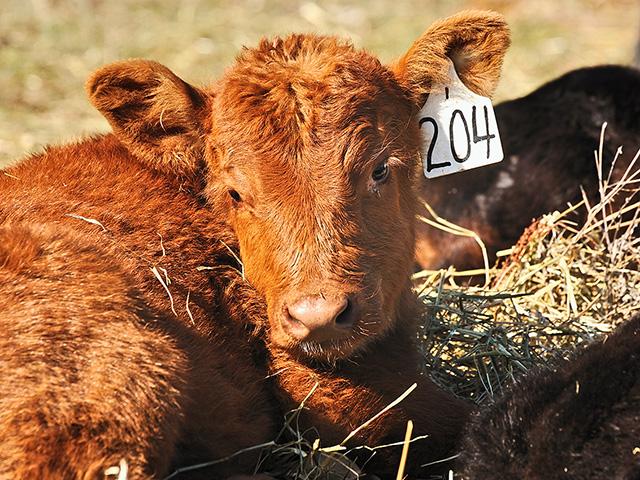Manage Hypothermia in Newborn Calves
Watch, Treat Hypothermia in Newborn Calves Especially in Winter Storms
OMAHA (DTN) -- A March winter storm is moving through the middle of the country, with rain and snow expected in many areas and even blizzard conditions in some regions.
Cow-calf producers need to keep a close eye on newborn calves in these types of harsh weather conditions. Certain management practices should be implemented to treat hypothermia in young calves.
WINTER STORM BRINGS SEVERE WEATHER
A large winter storm, with rain changing to snow, is moving eastward through the Central Plains into the Upper Midwest beginning March 4 and should move out by March 6. In a blog, DTN Ag Meteorologist John Baranick wrote it could be heavy and strong winds. (https://www.dtnpf.com/…)
Heavy thunderstorms in the eastern Plains moving through the Mississippi Valley will lead to flooding concerns in these areas.
"The intense storm will wrap enough moisture around the low-pressure center to produce a band of snow that could exceed 6 inches from northwestern Kansas and western Nebraska up through northern Wisconsin and the Upper Peninsula of Michigan," Baranick noted.
Winds are expected to pick up Tuesday into the 50-60 mph range from Nebraska to Texas. Where these winds coincide with the snow, blizzard conditions are likely from Nebraska up through Wisconsin, Baranick wrote. The National Weather Service has issued wind warnings of gusts up to 70 mph in some areas already by noon Tuesday for later in the afternoon.
"Though visibility and duration may not make for exact criteria for a true blizzard in all areas (35 mph winds with visibility less than one-quarter mile for at least three hours while snow is falling), travel hazards are going to be significant in this region and measuring the snowfall will be difficult to conduct accurately," Baranick wrote.
CALVING DIFFICULTES LEAD TO HYPOTHERMIA
P[L1] D[0x0] M[300x250] OOP[F] ADUNIT[] T[]
In a University of Nebraska-Lincoln (UNL) Extension report titled "Managing Hypothermia in Newborn Calves", author UNL Extension beef educator Linday Waechter-Mead wrote that preventing hypothermia is vital to survival of calves. (See that report here: https://beef.unl.edu/…)
A report in the 2007 National Animal Health Monitoring System noted 25.6% of operations reported weather as the main cause of death in calves less than three weeks old.
Dystocia (difficulty during birth) can have negative effects on calf health. When the delivery process is prolonged, calves will be born with critically low levels of blood oxygen. These low levels will be corrected when the calf begins to breathe.
Severe dystocia calves, however, have such low levels that the respiratory system is suppressed, leading to many negative events. This includes acidosis, which is an increase of blood carbon dioxide levels and the lack of oxygen.
Acidosis will suppress the central nervous system and lead to weak calf syndrome. In this situation, calves are unable to stand and likely have a decreased shivering response, which causes hypothermia.
"Hypothermic calves lack the suckle reflex and fail to ingest necessary colostrum, which will delay the absorption of antibodies and essential nutrients needed for survival," Waechter-Mead wrote.
Cow-calf producers do have several methods to assist a hypothermic calf. The first step would be to understand when to intervene. The normal rectal temperature of a newborn calf is 101.5-102.5 degrees Fahrenheit (F). Once the body temp drops below 101 degrees F, steps should be taken to prevent hypothermia.
Another tip is to place two fingers in the mouth of the calf. The inside of the mouth of a healthy calf will be warm and moist and they will attempt to chew or suck on your fingers. If the suckle reflex is absent, it is time to get involved.
TREAT HYPOTHERMIA EXTERNALLY AND INTERNALLY
Waechter-Mead wrote there are two routes when attempting to rewarm a calf -- external and internal.
Colostrum is the first line of defense for warming a calf internally. Made up of 10% fat, colostrum acts as a heat source by burning the fat into energy and maintaining body temperature.
Calves that sit sternal and hold their head up need colostrum to begin the warming process. The best source would be from the dam, but other sources or replacers may be used. An article from UNL details more about colostrum: https://beef.unl.edu/….
External warming can be achieved through commercial warming huts, forced warm air such as the floorboard of a pickup, or warm water bath. Never leave a calf unattended while using a heat source because there is potential for overheating.
While warming huts are a good option, they can be a breeding ground for pathogens. Thoroughly clean and disinfect the entire hut before adding another calf. If you use a bath, ensure the calve is completely dry before placing it back outside.
"Understanding the risk factors for hypothermia will aid in developing a strategy to prevent loss," Waechter-Mead wrote.
DTN wrote about cattle management in cold weather earlier this winter. Here are two articles:
-- "How to Prevent Cold Stress in Cattle," https://www.dtnpf.com/…
-- "Preparation Prevents Problems in Winter," https://www.dtnpf.com/…
Russ Quinn can be reached at Russ.Quinn@dtn.com
Follow him on social platform X @RussQuinnDTN
(c) Copyright 2025 DTN, LLC. All rights reserved.



